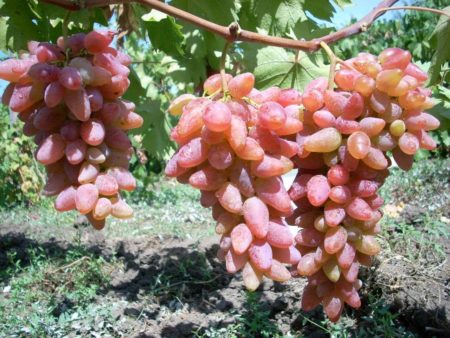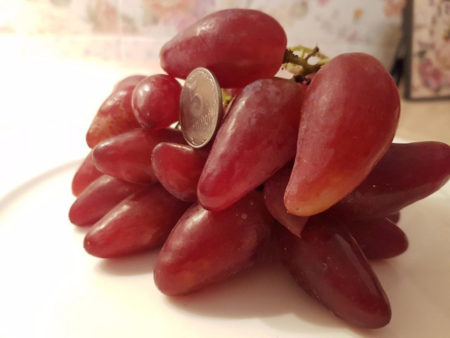The new hybrid form attracts with the beauty of the bunch, the harmonious taste of berries, their size. Characteristics of Dubovsky Pink appreciated by many winegrowers. Berries are also popular with customers; in the market, they diverge faster than others. Practice has shown that Dubovsky pink has good immunity, the bushes are resistant to fungal infection.
Content
Origin
Amateur selection, author S. E. Gusev used two parental forms during hybridization:
- Delight Red;
- Anniversary of Novocherkassk.
Title hybrid received in honor of the village of Dubovka, Volgograd region. It is in him S.E. Gusev was engaged in breeding work.
Grade description

Dubovskiy pink has no analogues in terms of growth. In this indicator, it is superior to other varieties. The form of early ripening (105-110 days), self-fertile, bisexual flowers. Propagated by root cuttings.
The clusters are impressive in size. The weight of the largest exceeds 2 kg, the average weigh about 1.5 kg. Their shape is conical, loose, wings can form. The berries are large, bright pink. The mass of the largest specimens is 20 g, length is from 3.5 to 5 cm. The shape of an elongated icicle, the nose is slightly narrowed, can slightly bend sideways.
The taste of ripe berries is harmonious without muscat and astringency, optimal sugar accumulation. When eating, the skin is not felt, there are few bones (1-2 pcs.), The flesh is fleshy, very juicy, if the bunch hangs on the bushes for a long time, it becomes denser. The taste is rated highly - 9.3 points.
Fruit Prescription:
- juice;
- compotes;
- wine;
- fresh use.
Bunches can be stored for up to several months. Dubovsky pink is of interest to farmers growing grape for sale. The bunches are not only well stored, they tolerate long-term transportation, while maintaining excellent commercial qualities.
Load and yield

Bushes are vigorous, can draw 1-2 clusters per fruiting shoot. A good harvest is obtained if 1 bunch is left. During flowering, experienced growers shorten the inflorescences to 30-35 cm, due to this they get the optimal cluster size.
The berry is colored in early August. At this time, selective cleaning begins. Rainy weather does not affect crop quality. A small percentage of berries suffer from cracking, only fruits that have previously suffered mechanical damage are affected. To obtain a commodity crop, the clusters on the bushes are not overexposed.
Winter hardiness
The threshold temperature that the bush withstands in winter is 24 ° C. This is a good indicator of frost resistance. A new hybrid, while it is grown in regions with a mild climate, only young vine bushes are covered for the winter, there is no information about freezing, but, according to experienced winegrowers, sheltering adult bushes will also not hurt.
Advantages
The hybrid has undoubted advantages. Bushes are decorative especially in August, when the berry is painted in amazing pink color. Dubovsky early stably harvested. Signal trees produce their own seedlings for 2 years, and cuttings grafted onto an adult vine yield in the first year.
Pluses of the Dubovsky pink hybrid:
- early ripening;
- productivity;
- transportability;
- resistance to mildew;
- excellent taste;
- frost resistance.
disadvantages
Reviews about the hybrid form are different. There are no descriptions of the obvious shortcomings of Dubovsky Pink.It is noted that if the clusters are left on the bushes, then they are damaged by wasps, the berries gain a lot of sugar, which makes them excessively sweet. The disadvantages include relative resistance to oidium.
Features of planting and care
The bushes are vigorous, therefore, when planting, an interval of 3-3.5 m must be observed. The vine fully reveals its potential when grown on two-plane trellises or on V-shaped ones with a hanging growth.Stepsons are removed partially. This is necessary so that wintering buds do not wake up. The load distribution allows you to accelerate the maturation of the buds, shoots, increases the winter hardiness of the bush.
Pinching stepsons of the 1st order get stepchildren of the 2nd order. The form is capable of bearing fruit on them. On each stepson of the 2nd order 1-2 inflorescences are formed. To get a crop on stepsons of the 1st order, in the spring, pinch the main shoot.
Top dressing and watering
Fruiting bushes respond well to organics. In the spring, a shallow trench (20-30 cm) digs on both sides of the bush, it is densely filled with humus. The second time, organic matter is brought under the bush after flowering. They take humus, mix it with a bit of rotten straw.
Scheme of proper irrigation: loading phase - every 7 days from the bush pour from 50 to 70 liters of water from a hose. For better ripening of wood, the bushes are sprayed with phosphorus-potash fertilizers.
Diseases and Pests
Resistance to oidium at the level of Arcadia. Dubovsky pink does not suffer from mildew. In order to prevent outbreaks of oidium, in August the bushes are treated with sulfur-containing fungicide Cumulus.
Berries suffer from wasps. Harvest save:
- with the help of a grid (bushes cover her);
- hide clusters in bags of gauze;
- sprayed with water and vinegar.
 Reviews
Reviews
Sofia, Ufa
In our region, the form has established itself well. The vine ripens well, does not get sick. We carry out only preventive treatments, there are enough of them. The grapes have a wonderful taste and look too.
Pavel, Volgograd
Dubovsky early satisfied. I grow grapes for sale, I am the first to take it apart. I can’t say that I have perfect care, but I don’t complain about the crops. In any weather I collect a lot. Rip one of the first. At the price of the most profitable. Taste and coloring at the height.
Inna, Krasnodar Territory
Dubovskaya pink was planted for the test, the first bunch was cut. Family appreciated the taste. They are very finicky, but in the assessment of Dubovsky were unanimous. The pulp of the berries is dense, juicy. On the brush they hold tight, outwardly very beautiful.




 Non-covering winter-hardy grape varieties for Moscow region
Non-covering winter-hardy grape varieties for Moscow region How to keep the vine in winter
How to keep the vine in winter When can I transfer grapes to another place in the fall
When can I transfer grapes to another place in the fall How to cover and prepare grapes for the winter in the suburbs
How to cover and prepare grapes for the winter in the suburbs